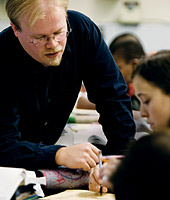Science Lessons
SPU receives $3.7 million grant from the National Science Foundation

Matthew Jones is one of many teacher-partners with SPU in a research project to transform the teaching of science. The project, funded by the National Science Foundation, focuses on how teachers engage with student ideas about science. |
A Raytheon survey of 11- to 13-year-olds found that 84 percent would rather clean their room, eat their vegetables, go to the dentist, or take out the garbage than learn math or science. In fact, fewer than half of U.S. high school graduates are ready for college-level math and science.
Like other eighth-grade science teachers, Matthew Jones has his work cut out for him. He also has multiple experiments going on in his Bellevue, Washington, classroom. Jones is part of a Seattle Pacific University research project analyzing how students think about the subject of physics — and how teachers engage, or fail to engage, their students’ ideas.
In October 2008, the SPU Physics Department received a five-year, $3.7-million grant from the National Science Foundation to fund this continued pioneering research of the teaching of physics in grade school through graduate school. The Physics Department is collaborating on the project with the Seattle Pacific School of Education; several local school districts; and FACET Innovations, an educational research and development company. Their ultimate goal, says Stamatis Vokos, professor of physics and head of the project, is to transform the teaching of science — and excite students’ attitudes toward science.
“At the national level, the teaching of science hasn’t changed much over the years,” he explains. “Not only do we need to prepare kids to think critically, but we also need teachers to better connect with students’ ideas about how things work in the natural world — and then to use those ideas productively in the instructional process.”
The NSF grant, titled “Honing Diagnostic Practice: Toward a New Model of Teacher Professional Preparation and Development,” extends a previous NSF grant to SPU that also focused on the challenges teachers face in recognizing and engaging student ideas. “This research has helped teachers like me bring out and address fundamental pre-conceptions students have about various science topics,” says Jones. “It has helped us determine what areas need to be addressed in our lessons so we can best impact student learning.”
Seattle Pacific faculty and students are working side-by-side with eighth-grade science teachers in Bellevue and other school districts. A student may express an incorrect, but sincere, idea about physics — for instance, that a moving object must have a force exerted on it in the direction of the motion. An SPU student makes an observation in the classroom, recording how the teacher responds to the student’s thoughts. The data is then given to the teacher, with the goal that he or she adapt instructional techniques based on how students modify ideas and form new ideas.
The first three years of research, says Vokos, shows that eighth-grade students in classrooms where teachers have al-tered their methods of teaching to accommodate facets of student learning are doing better on some tasks than students in 11th and 12th grade — and college — classrooms where teachers have not changed their instruction.
He explains that the grant is part of a broad-reaching effort by Seattle Pacific, with the help of its partners, “to become one of the preparers of exemplary teachers of science.” For the SPU research team, the current movement to start teaching physics in lower grades makes the need to discover more-effective ways to teach science even greater.
—Photo by Mike Siegel
Return to top
Back to Campus Home
|